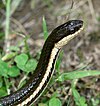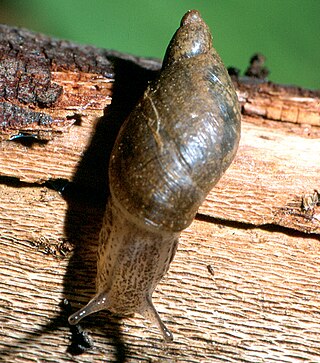This is a list of snake species known to be found in the U.S. state of Illinois. [1] Concerns and listed statuses come from the Illinois Endangered Species Protection Board's February 2011 Checklist of endangered and threatened animals and plants of Illinois and the Illinois Natural History Survey's website. [1] [2]
| Image | Scientific name | Common name | Family | Venomous | Conservation concern |
|---|---|---|---|---|---|
 | Agkistrodon contortrix | Eastern copperhead | Viperidae | Yes | Locally abundant |
 | Agkistrodon piscivorus | Northern cottonmouth Water moccasin | Viperidae | Yes | Locally abundant |
| Carphophis amoenus helenae | Midwestern worm snake | Colubridae | No | Locally abundant | |
 | Carphophis vermis | Midwestern worm snake | Colubridae | No | Locally abundant |
| Clonophis kirtlandii | Kirtland's snake | Colubridae | No | State Threatened | |
| Cemophora coccinea copei | Northern scarlet snake | Colubridae | No | Current existence in IL uncertain. Single specimen vouchered in 1942. | |
 | Coluber constrictor foxii | Blue racer | Colubridae | No | |
 | Coluber constrictor priapus | Southern black racer | Colubridae | No | Locally common |
 | Crotalus horridus | Timber rattlesnake Canebrake rattlesnake | Viperidae | Yes | State Threatened |
| Diadophis punctatus arnyi | Prairie ringneck snake | Colubridae | No | Locally abundant | |
 | Diadophis punctatus edwardsii | Northern ringneck snake | Colubridae | No | Locally abundant |
| Diadophis punctatus stictogenys | Mississippi ringneck snake | Colubridae | No | Locally abundant | |
| Farancia abacura reinwardtii | Western mud snake | Colubridae | No | Rarely seen | |
| Heterodon nasicus gloydi | Dusty hognose snake | Colubridae | No | ||
 | Heterodon nasicus nasicus | Plains hognose snake | Colubridae | No | State Threatened |
 | Heterodon platirhinos | Eastern hognose snake | Colubridae | No | Locally common |
 | Lampropeltis calligaster calligaster | Prairie kingsnake | Colubridae | No | Locally common |
 | Lampropeltis getula holbrooki | Speckled kingsnake | Colubridae | No | Locally common |
 | Lampropeltis getula niger | Black kingsnake | Colubridae | No | Locally common |
 | Lampropeltis triangulum triangulum | Eastern milk snake | Colubridae | No | Not commonly seen |
 | Lampropeltis triangulum syspila | Red milk snake | Colubridae | No | Not commonly seen |
 | Masticophis flagellum flagellum | Eastern coachwhip | Colubridae | No | State Endangered |
| Nerodia cyclopion | Mississippi green water snake | Colubridae | No | State Threatened | |
 | Nerodia erythrogaster flavigaster | Yellowbelly water snake | Colubridae | No | |
 | Nerodia erythrogaster neglecta | Copperbelly water snake | Colubridae | No | "protected as though it were listed in Illinois" [1] |
 | Nerodia fasciata confluens | Broad-banded water snake | Colubridae | No | State Endangered |
 | Nerodia rhombifer | Diamondback water snake | Colubridae | No | Locally common |
 | Nerodia sipedon pleuralis | Midland water snake | Colubridae | No | |
| Nerodia sipedon sipedon | Northern water snake | Colubridae | No | Abundant | |
 | Opheodrys aestivus | Rough green snake | Colubridae | No | Locally abundant |
 | Opheodrys vernalis | Smooth green snake | Colubridae | No | Not abundant |
 | Pantherophis emoryi | Great Plains ratsnake | Colubridae | No | State Endangered |
| Pantherophis spiloides | Gray ratsnake | Colubridae | No | Locally common | |
 | Pantherophis vulpina | Western fox snake | Colubridae | No | Locally common |
 | Pituophis catenifer sayi | Gophersnake Bullsnake | Colubridae | No | Locally common |
 | Pituophis melanoleucus melanoleucus | Northern pine snake | Colubridae | No | |
| Regina grahamii | Graham's crayfish snake | Colubridae | No | Widespread but uncommon | |
 | Regina septemvittata | Queen snake | Colubridae | No | Locally abundant |
 | Sistrurus catenatus catenatus | Eastern massasauga | Viperidae | Yes | |
 | Storeria dekayi wrightorum | Midland brown snake De Kay's brown snake | Colubridae | No | Common |
 | Storeria occipitomaculata occipitomaculata | Northern redbelly snake | Colubridae | No | Locally abundant |
 | Tantilla gracilis | Flat-headed snake | Colubridae | No | State Threatened |
| Thamnophis proximus proximus | Western ribbon snake | Colubridae | No | Locally common | |
 | Thamnophis radix | Plains ribbon snake | Colubridae | No | Common in north half of state |
 | Thamnophis saurita saurita | Eastern ribbon snake | Colubridae | No | State Threatened |
| Thamnophis saurita septentrionalis | Northern ribbon snake | Colubridae | No | ||
| Thamnophis sirtalis semifasciatus | Chicago garter snake | Colubridae | No | ||
 | Thamnophis sirtalis sirtalis | Common garter snake | Colubridae | No | Common |
| Tropidoclonion lineatum lineatum | Northern lined snake | Colubridae | No | State Threatened | |
 | Virginia valeriae elegans | Western earth snake | Colubridae | No |












